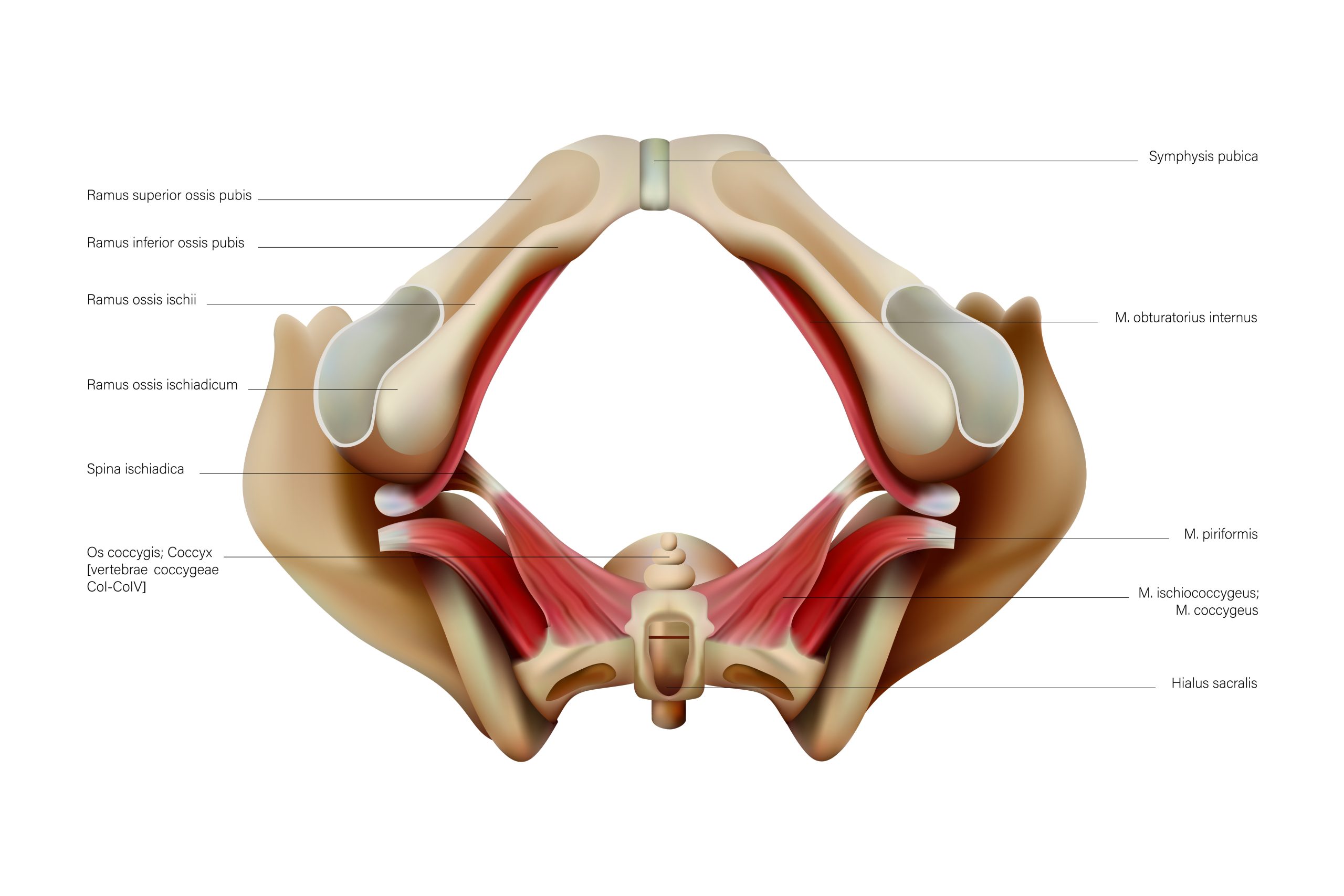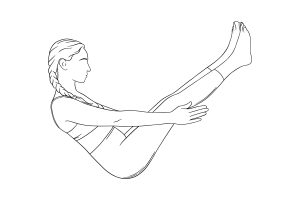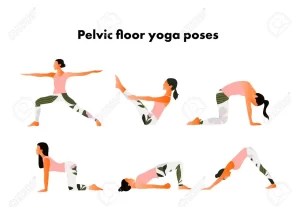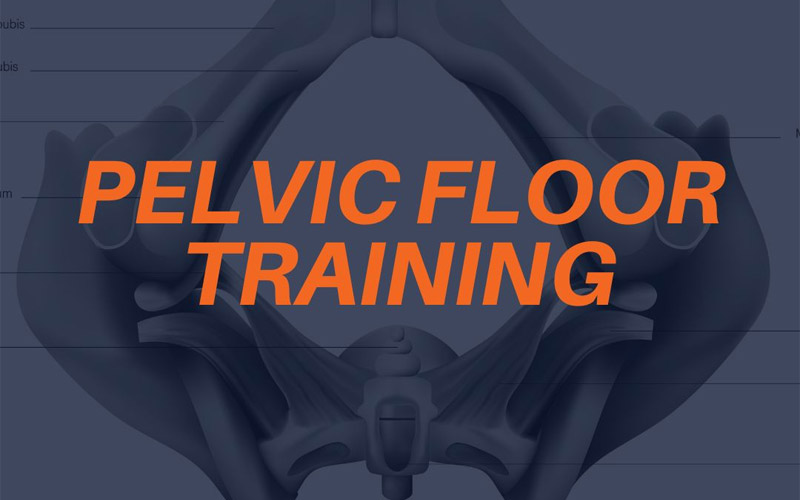Certified Personal Trainers may work with women and men who discreetly share that they can’t sleep through the night without an incontinent trip, or trips, to the bathroom and would benefit from pelvic floor training. Granted, voluntary control of bodily functions centered on one’s pelvic floor is a delicate subject, one not frequently broached by fitness professionals. Yet, pelvic floor muscle control is an important training topic for trainers and adult clients alike.
Note: Beyond incontinence, poor voluntary control of the pelvic floor can contribute to constipation, cold, tingly feet, low back and/or hip pain, and digestive issues. But first…
How rare or common is urinary incontinence (UI) in America?
And what, in anything, can women and men do about it?
Our National Institute of Health1 and the Illinois Department of Public Health, plus other credible resources provide statistics like these:
- About half of all women over age 50 experience either/both episodic or chronic UI symptoms.
- Note that UI issues are symptoms – not diseases.
- About one in 8 men in America experience, or will experience UI at some time in their lives.
- On an average day in America, about 13 million adults are incontinent.
- Most non-chronic symptoms of UI can be remediated without surgery by improving fitness and movement.
- Though encouraging in principle, these moving remediations may take several months to achieve success in practice.
- Root causes of gender-independent UIs may be regional surgery (examples are hysterectomy and prostatectomy), infection, stress, urge, obesity, or bladder overflow. Yes, heavy coughing, obesity, and heavy lifting may also be root causes of UI.

This article stresses that there is much more to pelvic floor health for all adults than performing proper Kegel exercises to address symptoms.
– You probably know that Kegels are focused muscular contractions and relaxations of “right muscles” that gynecologist Dr. Arnold Kegel championed in the 1940s. His original focus of “right” pelvic floor exercises, or Kegels (pronounced kay-gils) was to address female incontinence in a private, non-surgical way.
We now know that the health of pelvic skeletal muscles extends well beyond female incontinence (UI). We also know, from Dr. Kegel and many others, that focused pelvic region and deep core exercises are very effective for maintaining muscle mass and function.
An overview of key muscles, connective tissue, and bones of the human pelvic region is provided for trainers’ awareness.
Then, you will read about Pelvic Floor Muscle Training, or PFMT. Gaining or improving voluntary control of pelvic region muscle groups is either a self-help or supported protocol to help both women and men improve their activities of daily life (ADL). Expanded exercise routines to support bladder, bowel, and sexual wellness are provided.
Credible resources that professional trainers may share with adult clients are offered before a summary of the self-evident fact that men have pelvic floors, too.
Are You Floored?
Synopses of key muscles, connective tissue, and bones of the human pelvic region follow.
Inter-twined and layered pelvic floor muscles can be seen in this physio-pedia image. The viewpoint is upward-looking with female frontal anatomy at the top.
Shown with permission of physio-pedia.com:

Note: If a prolapse of the female pelvic floor occurs, the exhibited muscles allow internal organs to lapse downward away from the center of the body.
The predominant muscle group of the human pelvic floor is called the Levator Ani, or LA. This funnel-shaped, broad yet thin LA group has striated skeletal muscle fibers. Hammock-like LA muscles support and raise the pelvic floor for both genders as they accommodate important pelvic structures.
The LA has three discreet muscles in its groupage:
1. puborectalis
2. pubococcygeus
3. the iliococcygeus muscle.
As one NIH2 report advises, the neuromuscular function of this Pelvic Floor group has both voluntary and involuntary innervations. To reinforce the complexity of the Pelvic Floor3, there are 14 muscles in five layers plus important fascia and neural components that surround and interact with our bladder, gut, and reproductive organs. The LA muscle group is the middle, or third, layer of the Pelvic Floor (PF).
Of those 14 total muscles with long, Latin names, there is one that serves as our ringmaster for pelvic health – the pubococcygeus, or PC muscle. This vital LA muscle is linked between the anterior pubis bone and the posterior coccyx or tailbone. When this PC muscle voluntarily contracts, our other voluntary and involuntary muscles of the pelvic floor should respond in good ways.
Aging and many other life factors can adversely affect those voluntary “PC” contractions. Self-help or assisted PC exercises, including proper Kegels, done regularly for extended periods, may often improve an adult’s bladder, bowel, and reproductive functions. Though there are involuntary sphincters deep in the pelvic floor, you should think of focused, voluntary “training” of the PF muscles as you would other major muscle regions.
Pelvic Floor Muscle Training
With the complexity and inter-relationships of the entire Lumbo-Pelvic-Hip-Complex (LPHC) in mind, there are vital Pelvic Floor Muscle Training (PFMT) protocols that can benefit nearly all adults.
Yes, proper Kegels are included in comprehensive PFMT protocols. As one reminder, mindful breathing is essential.
Yet, other “deep core” muscles of the LPHC can help mitigate UI and other symptoms that impact one’s ADLs and quality of life(QoL).
The Psoas and Internal Oblique “corset” muscles are two important muscles of the LPHC to include in a regular PFMT protocol. Exercising the twin Psoas muscles with Dead Bug or Tin Soldier movements from supine positions work the corset-like deep core muscles above and around the Pelvic Floor.
A third deep core muscle, The Transverse Abdominus, or TVA, stabilizes the core, pelvis, and lower back. A Navasana (Boat Pose from Yoga), or Oyster movement can dramatically help proper PF functions.

As gluteal muscles are proximate to the PF, exercises such as Hip Thrusts and Squats enhance PF responsiveness.
Yes, Squat variations – with as much depth exhibited as possible in safe eccentric phases, promote that hamstrings strength to support PF health.
Donkey kick activation of your gluteals from a kneeling (hands-and-knees-and-toes) position is another proactive move to support PFMT.
Another supportive muscle for spinal support, the deep and long multifidus, helps stabilize the pelvic complex in movement.
The multifidus and other spinal/sacral stabilizers should be gently and regularly activated each day. Good posture is a starting point for PF health. One gentle PFMF movement is best done on the floor in a prone position with forehead placed on hands – straight downward:
- The client should subtly lift tailbone upward by rotating the pelvis back slightly. Hold for a second or two, then rotate the pelvis downward, pointing tailbone to the floor and repeat.
Yes, many Yoga asanas, with mindful breathing, are an eminently useful movement for PFMT. This image suggests four additional asanas that both women and men can and should perform to improve their PF wellness. Note: The boat pose and hip thruster asanas were mentioned previously in this post.

When properly done, these warrior poses, cat/cow shifts, plus down dogs are very useful for PFMT in women and men.
None of these listed pelvic floor training movements are time-consuming or aggressive. Therefore, even time-crunched adults or those with some remedial needs for personal training should make them habitual.
It is imperative to remind clients that pelvic floor and LPHC muscles benefit, over time, from varied volume, intensity, and tempo in movement characteristics. Slow movements or sustained “holds” favorably work the Type I “slow twitch” components, while quick, repetitive contractions support health of the Type 2 muscle fibers of the pelvic floor. Proper movement in all three body planes is recommended for optimal PFMT. Where can clients find more information about this formerly taboo topic of pelvic health?
Pelvic Floor Health Resources
There are many authoritative references for PF health and PFMT:
As stated, PF health is much more than addressing incontinence. Yet, the National Association for Continence is a fine online resource for broader PFMT practices.
The Memorial Sloan Kettering Cancer Center describes the proper protocol for men to do Kegels.
Harvard Health Publishing shares its step-by-step guide for proper PFMT to aid bladder and bowel function.
Pelvic Floor Training Takeaways
Whether the cause of a PF health issue is age, surgery, or another trigger, statistics show that millions of Americans have UI or other PF problems.
“One of the best ways to empower ourselves to have better pelvic floor health is to have a thorough understanding of what the pelvic floor is and its many functions.3
It is fascinating that the many-layered muscles in and around the pelvic floor are quite like the other muscles in our body that we use for exercise. Voluntarily use ’em or they lose their contractive functions.
No single movement or exercise is a “one-stop” protocol to improve the health of the Pelvic Floor, as it is supported by many muscles and tissues. Though remediation can take weeks or months, a majority of clients with PF issues can improve their QoL with exercise and focused movements – PFMT.
It is great counsel to suggest that a client seek a Physician to determine if she or he has a symptom that can be remediated with movement, or a disease that may require pharmaceutical or surgical intervention.
Yes, men have Pelvic Floors, too.
References
{1} Tran LN, Puckett Y. Urinary Incontinence. [Updated 2022 Aug 8]. In: StatPearls [Internet]. Treasure Island (FL): StatPearls Publishing; 2022 Jan-. Available from: https://www.ncbi.nlm.nih.gov/books/NBK559095/
{2} Gowda SN, Bordoni B. Anatomy, Abdomen and Pelvis, Levator Ani Muscle. [Updated 2022 Oct 26]. In: StatPearls [Internet]. Treasure Island (FL): StatPearls Publishing; 2022 Jan-. Available from: https://www.ncbi.nlm.nih.gov/books/NBK556078/
{3} https://www.intimina.com/blog/the-anatomy-of-14-pelvic-floor-muscles/
Dave Frost has served the fitness community as a NFPT-certified CPT since 2013, and a Master Fitness Trainer since 2019.
As a Medicare-aged baby boomer, he specializes in training those clients who intend to stay “well past forty”.
He is a former world champion in Masters Rowing and National Indoor Rowing champion for his age group. He is also a group fitness instructor for The Row House. His website is https://wellpastforty.com. Dave recently published his work: KABOOMER: Thriving and Striving into your Nineties to promote stamininety for those intending to add years to their lives and life to their years.


